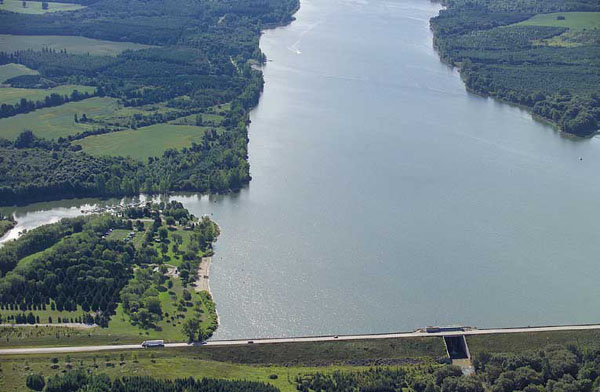
Wildwood Dam and Reservoir
Wildwood Dam and Reservoir – Q&A (June 2019)
Construction of a dam on Trout Creek, upstream of the Town of St. Marys, was proposed in 1948 as the first major project of the UTRCA after its formation in 1947. Originally designed as a flood control reservoir, there was considerable opposition and the project was shelved. It was thought that improving certain land use practices would be more effective at improving flood control.
The Upper Thames Valley Conservation Report (1952) modified the plans for the dam, proposing that in addition to providing flood protection to downstream communities, the reservoir supplement flows during the drier summer months. Construction began at the dam site in 1962 and finished in 1965. The cost of the dam and land base at that time was close to $3.5 million. Present annual maintenance costs are about $50,000.
Wildwood Dam and Reservoir are designed for both flow augmentation and flood control. The dam operation follows an annual cycle to supplement downstream flows during the drier summer months. At the beginning of the year, the reservoir is at approximately 3 metres, which is its winter holding level to maintain aquatic habitat. The low reservoir has room to manage winter floods and to store runoff from snowmelt and winter/spring rains, which is used to fill the reservoir to the summer conservation level of 6.55 m.
Approximately 10 million cubic metres of water are required to fill Wildwood reservoir from its winter holding level to its summer conservation level. This volume is the equivalent of 70 mm of water covering the entire area that drains into the reservoir.
Above the summer conservation level, there is an additional 6.3 million cubic metres of flood storage. This amount is equivalent to 44 mm of water covering the entire reservoir drainage area.
The flow augmentation period typically begins in late June. Water is gradually released from the reservoir, augmenting flows in Trout Creek and in the North Thames River downstream to London, providing water quality and aquatic habitat benefits. During a dry summer, this release from Wildwood Reservoir provides 25% to 50% (or more) of the flow in the North Thames River.
By late fall, the reservoir has been drawn down to its winter holding level, maintaining sufficient water for aquatic habitat while increasing flood storage for fall and winter floods and to be ready for the next spring runoff.
During a flood, the structure can reduce downstream flows on Trout Creek by storing flow in the reservoir and releasing it later. The level of flow reduction can range from 20% to 95%, depending on the type and severity of the flood and when it occurs. Trout Creek contributes only a small portion (13%) of the water that flows through St. Marys; thus, operations at Wildwood generally have a much less significant reduction of flows in the North Thames River.
Wildwood Dam is one part of the Upper Thames River Conservation Authority’s comprehensive flood management program. The dam is operated in a coordinated manner with reservoirs at Fanshawe Conservation Area (London) and Pittock Conservation Area (Woodstock). This operation optimizes flood control and low flow augmentation efforts for the North Thames River in St. Marys and for the Thames River watershed in general.
A 550 metre long floodwall constructed in 1990 where Trout Creek and the North Thames River meet protects downtown St. Marys from flooding up to the floodwall’s designed level of protection (100 year flood).
Facts about Wildwood Dam and Reservoir
- Completed: 1965
- Cost: $2,180,000 (1965 dollars)
- Who paid: Provincial government 37.5%, Federal government 37.5%, UTRCA 25% (benefitting watershed municipalities)
- Drainage area: 141 square kilometres
- Length of dam – 640 m
- Maximum width of dam at base – 104 m
- Reservoir at summer conservation level:
- Length – 9 km
- Width – 460 m
- Water surface area – 385 ha (950 acres)
- Volume of water required to fill reservoir from winter holding level to summer conservation level: 10 million cubic metres
- Flood storage space available when reservoir is at summer conservation level: 6.3 million cubic metres
Operating Features
Wildwood Dam is designed for both flow augmentation and flood control purposes. The outflow from the dam is controlled by three main operating features:
- Four large sluice gates provide coarse control of flows from the dam. These gates are used mainly during the spring runoff period (March- April) and during the fall and early winter when the soil may be frozen or saturated and runoff from snow melt or rainfall is potentially high.
- Three small valves located in the core of the dam below the winter water level provide fine control of outflow during the summer and other times when often even less flow enters into the reservoir. The valves also allow discharges of cooler water from the bottom of the reservoir during the summer. By using the valves, the reservoir can be further lowered for maintenance purposes.
- Concrete baffle walls above the gates provide some automatic control during the early summer months when the reservoir level is at or close to its highest level. Water can spill over the walls when the reservoir rises following summer storms.
Reservoir Operations
A minimum volume of water is released downstream during the summer months. An annual operating cycle guideline was established within the original design for the dam and reservoir. The cycle indicates continuous changes in water levels during the year. The fluctuations provide optimum year round flood control capability to protect downstream communities without endangering the safe operation of the dam, and benefits water quality downstream during dry summer conditions.
Safety around Dams (MNRF webpage)

